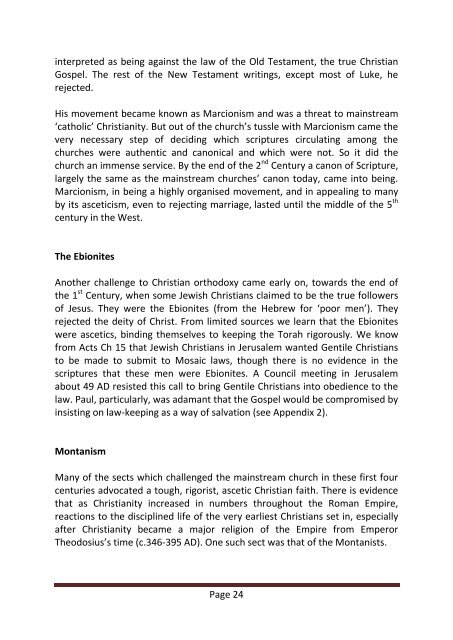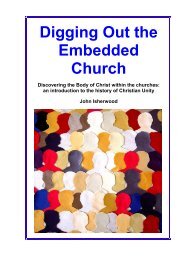Christian Unity (the book) - The Maranatha Community
Christian Unity (the book) - The Maranatha Community
Christian Unity (the book) - The Maranatha Community
Create successful ePaper yourself
Turn your PDF publications into a flip-book with our unique Google optimized e-Paper software.
interpreted as being against <strong>the</strong> law of <strong>the</strong> Old Testament, <strong>the</strong> true <strong>Christian</strong>Gospel. <strong>The</strong> rest of <strong>the</strong> New Testament writings, except most of Luke, herejected.His movement became known as Marcionism and was a threat to mainstream‘catholic’ <strong>Christian</strong>ity. But out of <strong>the</strong> church’s tussle with Marcionism came <strong>the</strong>very necessary step of deciding which scriptures circulating among <strong>the</strong>churches were au<strong>the</strong>ntic and canonical and which were not. So it did <strong>the</strong>church an immense service. By <strong>the</strong> end of <strong>the</strong> 2 nd Century a canon of Scripture,largely <strong>the</strong> same as <strong>the</strong> mainstream churches’ canon today, came into being.Marcionism, in being a highly organised movement, and in appealing to manyby its asceticism, even to rejecting marriage, lasted until <strong>the</strong> middle of <strong>the</strong> 5 thcentury in <strong>the</strong> West.<strong>The</strong> EbionitesAno<strong>the</strong>r challenge to <strong>Christian</strong> orthodoxy came early on, towards <strong>the</strong> end of<strong>the</strong> 1 st Century, when some Jewish <strong>Christian</strong>s claimed to be <strong>the</strong> true followersof Jesus. <strong>The</strong>y were <strong>the</strong> Ebionites (from <strong>the</strong> Hebrew for ‘poor men’). <strong>The</strong>yrejected <strong>the</strong> deity of Christ. From limited sources we learn that <strong>the</strong> Ebioniteswere ascetics, binding <strong>the</strong>mselves to keeping <strong>the</strong> Torah rigorously. We knowfrom Acts Ch 15 that Jewish <strong>Christian</strong>s in Jerusalem wanted Gentile <strong>Christian</strong>sto be made to submit to Mosaic laws, though <strong>the</strong>re is no evidence in <strong>the</strong>scriptures that <strong>the</strong>se men were Ebionites. A Council meeting in Jerusalemabout 49 AD resisted this call to bring Gentile <strong>Christian</strong>s into obedience to <strong>the</strong>law. Paul, particularly, was adamant that <strong>the</strong> Gospel would be compromised byinsisting on law-keeping as a way of salvation (see Appendix 2).MontanismMany of <strong>the</strong> sects which challenged <strong>the</strong> mainstream church in <strong>the</strong>se first fourcenturies advocated a tough, rigorist, ascetic <strong>Christian</strong> faith. <strong>The</strong>re is evidencethat as <strong>Christian</strong>ity increased in numbers throughout <strong>the</strong> Roman Empire,reactions to <strong>the</strong> disciplined life of <strong>the</strong> very earliest <strong>Christian</strong>s set in, especiallyafter <strong>Christian</strong>ity became a major religion of <strong>the</strong> Empire from Emperor<strong>The</strong>odosius’s time (c.346-395 AD). One such sect was that of <strong>the</strong> Montanists.Page 24








